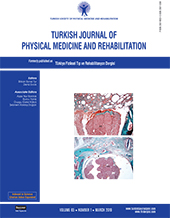Effectiveness of electrical stimulation after administration of botulinum toxin in children with spastic diplegic cerebral palsy: A prospective, randomized clinical study
2 Department of Physical Medicine and Rehabilitation, Çukurova University Faculty of Medicine, Adana, Turkey DOI : 10.5606/tftrd.2019.2236 Objectives: The aim of the study was to investigate the effectiveness of electrical stimulation to agonist muscles after injection of Botulinum toxin A (BTX-A) in children with spastic diplegic cerebral palsy (SDCP).
Patients and methods: Between October 2009 and October 2010, 38 patients with SDCP (19 males, 19 females; mean age 6.3 years; range, 4 to 10 years) were included. The patients were able to walk independently or with minimal assistance by foot equine and had spasticity in the calf muscles between Grades 1+ and 3 according to the Modified Ashworth Scale (MAS). The patients received either BTX-A injection + electrical stimulation (Group 1, n=19) or BTX-A injection alone (Group 2, n=19). All patients were evaluated using the MAS, Penn Spasm Frequency Scale (PSFS), Gross Motor Function Measure-88 (GMFM-88) (Dimensions D and E), and walking velocity.
Results: A decrease in spasticity was evident for the right, left, and bilateral lower extremities for both groups (p<0.05). There were no statistically significant differences in the MAS, PSFS, GMFM-88 (Dimensions D and E), and walking velocity between the groups.
Conclusion: Our study results showed that both patient groups benefited from the treatment and the administration of electrical stimulation to the gastrocnemius motor points produced no additional benefit for patients with SDCP.
Keywords : Botulinum toxin, cerebral palsy, electrical stimulation, spasticity

















